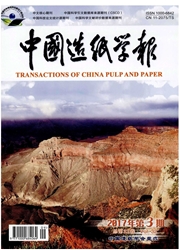

 中文摘要:
中文摘要:
用由Co—salen、吡啶、H2O2、O2组成的Co—salen型仿酶体系对β-0-4型木质素模型化合物——愈创木基丙三醇-β-愈创木基醚进行仿酶降解,并用GC—MS等方法分析β-0-4型木质素模型化合物在降解过程中的结构变化,并在此基础上初步探讨了Co—salen型仿酶体系对木质素的降解机理。结果表明:Co—salen型仿酶体系对β-0—4型木质素模型化合物有较强的降解能力,降解后产生一系列含羟基、醛基和羧基的芳香族低分子化合物,根据反应产物的结构可以说明β-0-4型木质素模型化合物的主要降解途径为β-0—4醚键、Cα-Cβ键、烷基-芳基键的断裂和苯环开环反应等。
 英文摘要:
英文摘要:
In order to understand reaction mechanism of lignin with Co-salen, a lignin model compound of phenolic β-O-4 type, i.e. guaia- cylglycerol-fl-guaiacyl ether was treated with a novel delignification system containing Co ( Ⅱ ) salen, pyridine, hydrogen peroxide, oxygen ( Co-salen system). The GC-MS analysis was used to investigate the change of chemical structure ofβ-0-4 type model compound during the reaction. Mechanism of this biomimetic delignification was also discussed. Results showed that Co-salen type biomimetic system has strong ability to degrade MWL phenolic β-0-4 type model compound. After degradation, a series of low molecular aromatic compounds containing carboxyl, hydroxyl and carbonyl groups are produced. Based on their structures, it is suggested that the following reactions are caused by the Co-salen system: ether-bond cleavage, Cα-Cβ cleavage, alkyl-aryl cleavage and aromatic ring opening. Consequently, this work provides convincible information about Co-salen biomimetic delignification system that could be applied to commercial non-pollution bleaching.
 同期刊论文项目
同期刊论文项目
 同项目期刊论文
同项目期刊论文
 期刊信息
期刊信息
